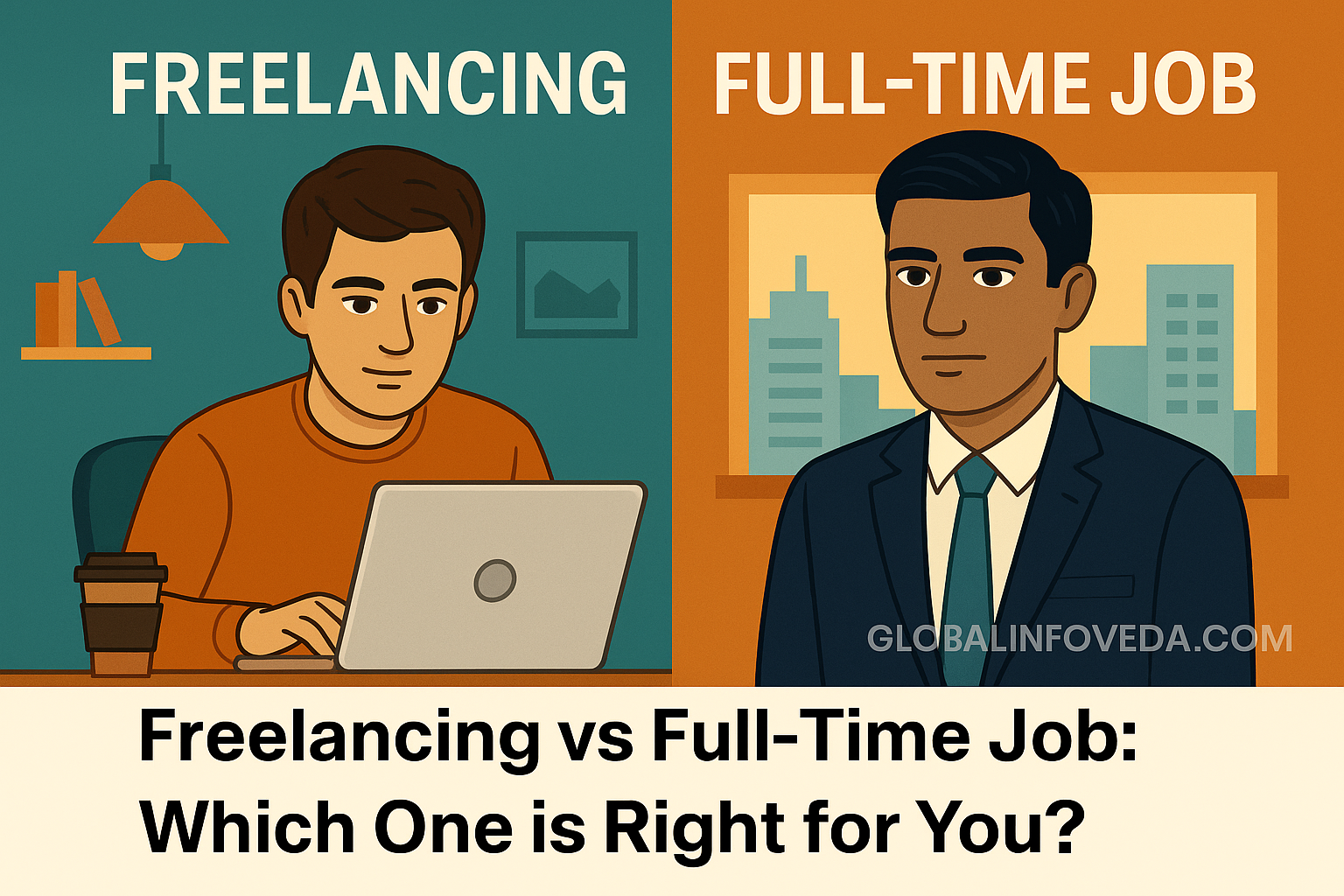🔍 Introduction
In 2025, the nature of work is more dynamic than ever. With the rise of remote work, freelancing platforms like Upwork and Fiverr, and a shift in employee expectations, more people are exploring non-traditional employment. Choosing between freelancing and full-time work is no longer just about job titles — it’s about how you want to live, earn, and grow.
This guide will help you understand the core differences between freelancing and full-time employment, and help you make the right choice based on your personal goals, lifestyle preferences, and financial needs.
🕒 1. Work Structure & Flexibility
✅ Freelancing:
- Complete Flexibility: Set your own hours, work from cafes, beaches, or your living room.
- Client Control: Decide who you want to work with and what projects you take.
- No Boss: You are in charge of your business.
- Examples: A freelance graphic designer may work 4 hours a day and still earn more than a full-time designer.
❌ Challenges:
- May work late nights or weekends to meet client deadlines.
- No clear line between personal and professional time.
- Requires self-discipline and time management tools.
✅ Full-Time Job:
- Fixed Working Hours: Usually 9 to 5 or shift-based.
- Structured Workflow: Weekly targets, manager reviews, meetings.
- Predictable Routine: Ideal for those who like daily consistency.
- Examples: A full-time software developer works with a team, has regular standups, and receives project milestones.
❌ Challenges:
- Little room for personal errands during work hours.
- May feel monotonous or creatively limiting over time.
💰 2. Income & Financial Security
✅ Freelancing:
- Unlimited Potential: You can scale your earnings by increasing rates or handling more projects.
- Global Reach: Freelancers can earn in USD/EUR while living in India.
- Low Entry Cost: Many freelance jobs need only a laptop and skillset.
❌ Challenges:
- Seasonal Slumps: May earn more in some months and very little in others.
- Client delays in payments are common.
- Must track and file taxes as self-employed.
✅ Full-Time Job:
- Consistent Paycheck: Helps with monthly budgeting and loan approvals.
- Job Perks: Bonuses, allowances, paid leaves, gratuity.
- Social Security: Provident Fund (PF), ESI, gratuity, and insurance.
❌ Challenges:
- Raises and promotions often depend on company policies.
- Layoffs or cost-cutting can still lead to job loss.
🛠️ 3. Skill Development & Career Progression
✅ Freelancing:
- Learn faster by working across industries and client needs.
- Push yourself to stay ahead in your niche (courses, certifications).
- Build a strong portfolio, personal brand, and client referrals.
- Freedom to switch specializations at any point.
❌ Challenges:
- No formal mentorship or feedback system.
- You are responsible for your own career roadmap.
✅ Full-Time Job:
- HR-led upskilling programs, workshops, and certifications.
- Defined career ladders, with promotions and appraisals.
- Team-based learning from peers and seniors.
❌ Challenges:
- May require multiple approvals for skill development courses.
- Promotions depend on company health, politics, and timing.
🧘♀️ 4. Lifestyle, Health & Work Culture
✅ Freelancing:
- Design your day to suit your lifestyle (work 4 hours, rest 4 hours).
- Opportunity to travel, spend time with family, pursue hobbies.
- Avoid daily commute, office dress code, and rigid schedules.
❌ Challenges:
- Social isolation, especially for extroverts.
- Hard to separate workspace and personal space.
- No employee wellness or mental health benefits.
✅ Full-Time Job:
- Regular interaction with coworkers boosts morale.
- Wellness programs, offsites, annual retreats.
- Clear HR policies on grievances, leave, harassment.
❌ Challenges:
- Long commutes, fixed workspaces, limited breaks.
- More stress during crunch seasons and KPIs.
📊 5. Security, Insurance & Retirement
✅ Freelancing:
- Must arrange personal insurance and investments (Term plans, SIPs).
- No PF, gratuity, or job protection.
- Easier to adapt to a gig-based world, but without a financial safety net.
✅ Full-Time Job:
- Insurance provided for self and family.
- EPF, gratuity, paid leaves, and severance pay.
- Government compliance ensures labor rights and safety.
🧾 Final Verdict: Which Is Right for You?
| Factor | Freelancing | Full-Time Job |
|---|---|---|
| Flexibility | Maximum control | Limited |
| Income Stability | Variable (but scalable) | Predictable and fixed |
| Skill Variety | High exposure | Deep specialization |
| Team Environment | Solo work | Collaborative |
| Long-Term Security | Self-driven | Provided by company |
| Benefits | Self-arranged | Health, PF, leave, insurance |
🧭 When to Choose Freelancing:
- You’re entrepreneurial and love autonomy.
- You’re confident in marketing your services.
- You want freedom over your daily schedule.
- You’re okay managing taxes, invoices, and clients.
🏢 When to Choose Full-Time Employment:
- You seek income stability and long-term benefits.
- You’re early in your career and need mentoring.
- You prefer working in teams and large organizations.
- You want clear, incremental growth and promotions.
📝 Final Advice:
In many careers today, you can start with a job, build skills, and gradually shift to freelancing. Others prefer a hybrid model — a stable job with side freelance gigs for extra income.
Ultimately, the best option is the one that aligns with your lifestyle, risk tolerance, and future vision.
🌐 Read more in-depth career tips, growth hacks, and digital earning guides at GlobalInfoVeda.com
